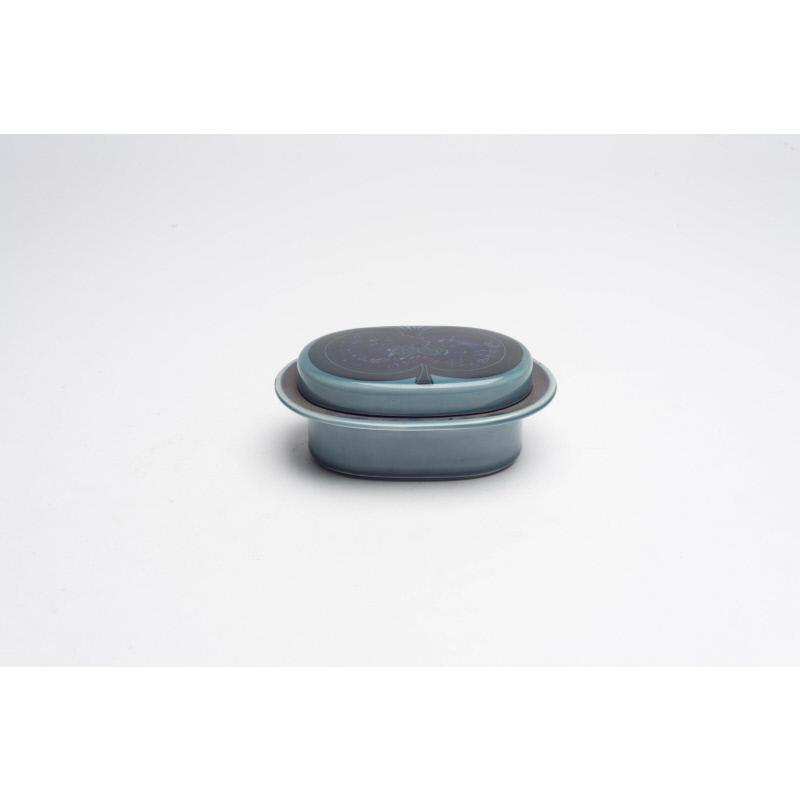Currently indexing
Butter dish
Classification(s):
Pottery
Date: c. 1951-1976
Organisation: Arabia (Finland, founded 1873)
Designer: Gunvor Olin-Grönqvist
Dimensions:
70 × 177 mm (7 × 17.7 cm)
Medium: Ceramic
Object number: P828M
See Also
(not assigned):Sweden
DescriptionGlazed ceramic butter dish with lid, designed by Gunvor Olin-Grönqvist for Arabia. Made in Sweden. The butter dish has a blue glaze and a hand painted-design to the lid depicting a cross-section of a seeded fruit, possibly a tomato.
Maker’s mark painted to underside “Arabia Finland GOG/ELS”. Incised under the glaze “S”. ILEA number to underside of dish and lid. The lid has a different ILEA number (P828H) and therefore belongs to a different set.
Maker’s mark painted to underside “Arabia Finland GOG/ELS”. Incised under the glaze “S”. ILEA number to underside of dish and lid. The lid has a different ILEA number (P828H) and therefore belongs to a different set.
ProvenanceThis object was originally acquired for the Inner London Education Authority’s (ILEA) ‘Circulating Design Scheme’ collection.
The collection was instigated by the London Country Council (later the Greater London Council) and the Council of Industrial Design (COID). The collection’s original purpose was concerned with the teaching and dissemination of modern, ‘good design’.
The collection was established in 1951/52 as the ‘Experiment in Design Appreciation’, later renamed the ‘Circulating Design Scheme’.
The Circulating Design Scheme lent boxed showcases to London schools. The showcases contained handling objects, material samples and interpretation on a specific subject.
COID withdrew its involvement in the Scheme in 1957. After which time, it was managed exclusively by the London County Council from 1957-1963.
After the administrative restructuring of London authorities, the Scheme was jointly managed by the Greater London Council and the Inner London Education Authority (ILEA) from 1963 – 1976.
The Scheme was operational until 1976 when the collections were withdrawn from circulation. ILEA was abolished in the late 1980s and the collection was donated to Camberwell College of Arts in 1989/90.
ILEA was responsible for secondary and tertiary education in the inner London boroughs, this included Camberwell.
The collection was instigated by the London Country Council (later the Greater London Council) and the Council of Industrial Design (COID). The collection’s original purpose was concerned with the teaching and dissemination of modern, ‘good design’.
The collection was established in 1951/52 as the ‘Experiment in Design Appreciation’, later renamed the ‘Circulating Design Scheme’.
The Circulating Design Scheme lent boxed showcases to London schools. The showcases contained handling objects, material samples and interpretation on a specific subject.
COID withdrew its involvement in the Scheme in 1957. After which time, it was managed exclusively by the London County Council from 1957-1963.
After the administrative restructuring of London authorities, the Scheme was jointly managed by the Greater London Council and the Inner London Education Authority (ILEA) from 1963 – 1976.
The Scheme was operational until 1976 when the collections were withdrawn from circulation. ILEA was abolished in the late 1980s and the collection was donated to Camberwell College of Arts in 1989/90.
ILEA was responsible for secondary and tertiary education in the inner London boroughs, this included Camberwell.
NotesGunvor Olin-Grönqvist worked at the Arabia factory in its Design Department from 1951. As an artist she is known for her depictions of fruits and vegetables. This theme ran through both her industrial design and studio work.







